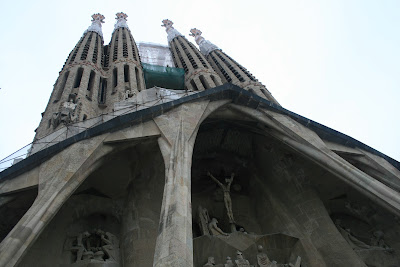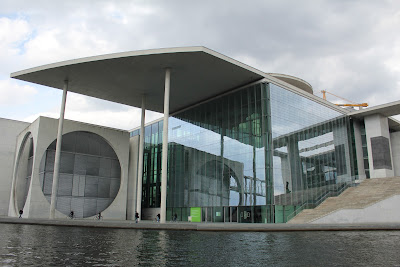"I have been in Europe for 79 days now. I would say that it has been something
more than just an experience.
There have been challenges, such as the language barrier, but through
these challenges I have grown as a person. I knew from the start that I would see a lot of new and
interesting things, but as I near the end, that statement becomes more and more
of an understatement.
After the submittal of our final project for the semester we
have had free travel time since April 9th. From the beginning of the trip I had wanted to go to
Barcelona. So to start out this
free travel time myself and three other classmates decided to go to Spain. We booked an overnight train from Paris
to Barcelona, and arrived on the morning of April 10th.
My first impression of Barcelona was that it was a dense
clean city. The palm trees were a
change from the vegetation of northern Europe that I was used to. As we roamed
the city searching for our hostel we learned of the underground metro. The metro system in Barcelona connects
the city and makes traveling without car very simple. The system even links to outlying areas of Barcelona, which
would be rather inaccessible otherwise.
We eventually found our hostel and made our way to the roof deck where
you could get an amazing view over the city.
One of the first things that I wanted to see after arriving
in Barcelona was to visit the Sagrada Familia designed by Antonio Gaudi. It is an architectural example of an
artist’s masterpiece. Upon
arriving at the basilica which is still an active construction site, the
ornamental carvings and towers are humbling. But the real experience of the Sagrada Familia is on the
inside. It is a space that is hard
to capture with words or even pictures.
The composition of both grand gestures and extreme detail kept me
silently interested for an extended period of time.
The historic center of the city has narrow streets and an
even higher density than the newer surroundings. This area is composed of shops on the ground level and
mostly residential above. The
cobble stone streets give you a sense of the rich history of the city by the sea. The
Mediterranean is vital to forming the identity of Barcelona. Sea food is abundant as you walk the
streets especially as you get closer to the beach. An expansive beach paired with the paved walkway with shops,
makes Barcelona’s beach special.
We were there for the start of the beach season, but as the weather warms
in the summer the beach seems as if it will become more and more vibrant. Watching as Barcelona transformed from
their somewhat quiet winter to their exciting summer was well worth the
trip.
After Barcelona we traveled through southern France, and are
now on our way to Venice and Rome before flying back to the U.S. As I look forward to my final week
abroad I can only feel thankful for the opportunity to see what I now realize
is only a small part of the world.
If this trip has taught me anything it is that the world is vast and
diverse. It has been a humbling
learning experience that will stay with me for the rest of my life." - David Booth
As students, real world is another class in architecture and design except for a bigger one. We students learn from architects/designers who have been in practice for a long time or more than us. Especially from architects that have engraved their names in architecture for decades and some for centuries. Why “re-invent the wheel”, learn from experiences so we won’t go over the same issues that some nations have been through.
As designers, we need to be exposed to as many design techniques and skills that have been in practice before us as possible in-order for us to be able to pick the path that would be in favor for us. Watching designs in books, magazines, internet…etc is not enough. Architects are designers and design is beyond what you may see, in fact, architecture is all about feeling and responsibility towards the environment. Unless you feel the design you will not get as much as you should from the design.
As architects, we need to live with people, experience their life-style. Clients can come from absolutely different cultures and different worlds. We don’t have to learn about all the cultures in the world, however, we need to learn how to react with new ones. We learn new things every day, we can’t learn everything. As architects, we need to know a little bit of everything, not everything about one thing. Even dealing with people here in Europe taught me that the architecture that I would plan to do for myself after graduation is not as easy as just showing a portfolio, in fact, it is how you react with those clients that make them think you are worth the money they are willing to spend on.
And the list goes on and on. European architecture is very different from the US scale wise, materials, roads and city layouts and geometry, uses of places and many other characteristics. Almost every city I’ve been to had a different feeling from the others even though some were from one country. I believe if I was taken back to Europe to any of the places I’ve been to without telling me where I am, I definitely would be able to name the place even if there was no signs of the identity of the place such as language, car plates…etc. The environment and characteristics of each place I’ve been to was unique and exclusive.
To sum, I would like to take the opportunity to highly suggest everyone in the ALA program take this semester abroad term before graduation. It is an opportunity that will never happen after graduation since responsibilities become more and more after getting a job.
Also, if you’re thinking of working with any of your classmates and would really want to commit with them, this travel reveals all the hidden about your classmates! Good things and bad things. If you want to know people better, travel with them. Yes it is expensive way but think how 3 months may and may not change your life decision to commit with someone." -Ali AlQattan




















































